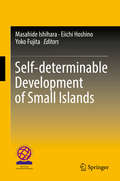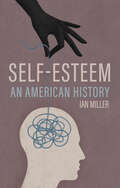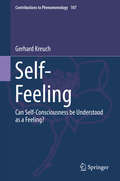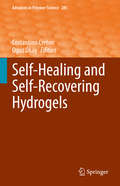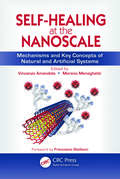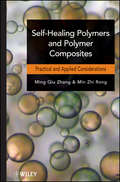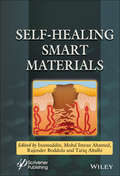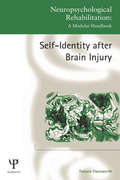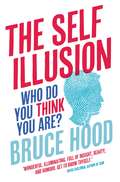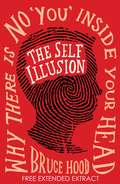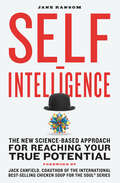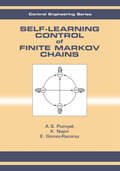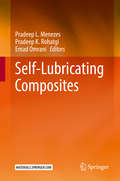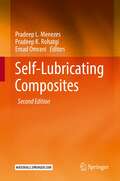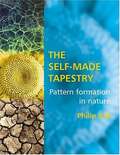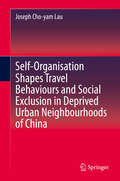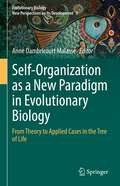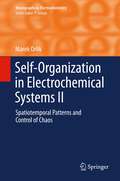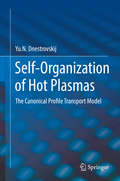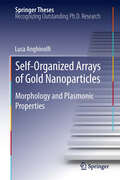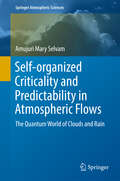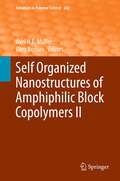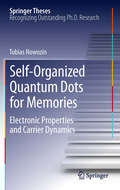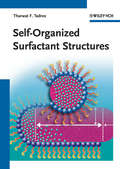- Table View
- List View
Self-determinable Development of Small Islands
by Masahide Ishihara Eiichi Hoshino Yoko FujitaThis book aims to clarify the present situation of the relations between small island countries and territories on the one hand and the great powers, mainland areas, and mega-islands on the other, and explores how small island countries and territories preserve and build their identity under globalization. This book is divided into five parts. The first part presents papers on issues that are related to Okinawa: the American military presence, the formation of a global human network, and the history of and language revitalization in Okinawa. The second part includes papers on security in East Asia and the Pacific Region: the history of and present issues in international relations within the South and East China Sea areas. The third part presents papers on economic issues and social developments on small islands. The fourth part deals with ocean policies and marine resource management in the Pacific Region by the United States, Australia, and Japan. Finally, the fifth part presents papers on the revitalization of three indigenous languages. All the chapters of the book are based on the achievements of the research project "Towards New Island Studies: The Ryukyus as an academic node between East Asia and Oceania" conducted by the International Institute for Okinawan Studies at the University of the Ryukyus. This 5-year project was funded by the Japanese Ministry of Education, Culture, Sports, Science and Technology and aimed to contribute academically to the creation of sustainable and self-determinable societies in small island regions. This work will be extremely useful and informative for readers in small island countries and territories and for researchers who are interested in small island issues to understand the current situation and who wish to consider effectual and feasible solutions.
Self-Esteem: An American History
by Ian MillerAt the end of the last century, the idea of self-esteem became enormously influential. A staggering amount of psychological research and self-help literature was published, and before long was devoured by readers. Self-esteem initiatives permeated American schools. Self-esteem became the way of understanding ourselves, our personalities, our interactions with others. Nowadays, few people think much about the idea of self-esteem—but perhaps we should.Self-Esteem: An American History is the first historical study exploring the emotional politics of self-esteem in modern America. Written with verve and insight, Ian Miller’s expert analysis explores the critiques of self-help which accuse it of propping up conservative agendas by encouraging us to look solely inside ourselves to resolve life’s problems. At the same time, he reveals how African American, LGBTQ+ and feminist activists endeavored to build positive collective identities based upon self-esteem, pride and self-respect.This revelatory book will be essential reading for anyone with an interest in the history of mental health, well-being, emotions in the United States’ unique society and culture.
Self-Feeling: Can Self-Consciousness be Understood as a Feeling? (Contributions to Phenomenology #107)
by Gerhard KreuchThis monograph offers new insights into the connection between self-consciousness and emotion. It focuses on what fundamental “feelings of being” tell us about ourselves. The results enrich the philosophy of human affectivity and help shed new light on some pressing, current problems. The author seeks to understand self-consciousness as an affective phenomenon, namely as self-feeling. He identifies it as a pre-reflective, pre-propositional, bodily feeling that shapes our space of possibilities. It is the affective disclosure of individual existence. His account overcomes the difficulties of infinite regress and vicious circularity that reflective (or higher-order) accounts of self-consciousness struggle with. At the same time, it helps build a bridge between the basic level of self-consciousness and the higher level of more substantial thoughts about oneself. The title explores fundamental affectivity, Matthew Ratcliffe’s theory of existential feelings, features of self-feeling, and appropriateness and inappropriateness in self-interpretation. It also considers the contributions of the Heidelberg School of self-consciousness to current debates. The title provides students and researchers with a unique look into such vital philosophical questions as: What is self-consciousness? How do we know ourselves? It will also appeal to a wider audience interested in self-consciousness and/or human affectivity since it does not presuppose knowledge of the jargon.
Self-Healing and Self-Recovering Hydrogels (Advances in Polymer Science #285)
by Costantino Creton Oguz OkayThis volume covers experimental and theoretical advances on the relationship between composition, structure and macroscopic mechanical properties of novel hydrogels containing dynamic bonds. The chapters of this volume focus on the control of the mechanical properties of several recently discovered gels with the design of monomer composition, chain architecture, type of crosslinking or internal structure. The gels discussed in the different chapters have in common the capability to dissipate energy upon deformation, a desired property for mechanical toughness, while retaining the ability to recover the properties of the virgin material over time or to self-heal when put back in contact after fracture. Some chapters focus on the synthesis and structural aspects while others focus on properties or modelling at the continuum or mesoscopic scale. The volume will be of interest to chemists and material scientists by providing guidelines and general structure-property considerations to synthesize and develop innovative gels tuned for applications. In addition it will provide physicists with a better understanding of the role of weak interactions between molecules and physical crosslinking on macroscopic dissipative properties and self-healing or self-recovering properties.
Self-Healing at the Nanoscale: Mechanisms and Key Concepts of Natural and Artificial Systems
by Vincenzo Amendola Moreno MeneghettiA complete panorama of self-healing strategies, Self-Healing at the Nanoscale: Mechanisms and Key Concepts of Natural and Artificial Systems focuses on the development of new nanoscale self-healing systems, from general concepts to physical chemical mechanisms. With a special emphasis on key concepts, strategies, and mechanisms at the atomic, molec
Self-Healing Polymers and Polymer Composites
by Ming Qiu Zhang Min Zhi RongA state-of-art guide on the interdisciplinary aspects of design, chemistry, and physical properties of bio-inspired self-healing polymers Inspired by the natural self-healing properties that exist in living organisms-for example, the regenerative ability of humans to heal from cuts and broken bones-interest in self-healing materials is gaining more and more attention. Addressing the broad advances being made in this emerging science, Self-Healing Polymers and Polymer Composites incorporates fundamentals, theory, design, fabrication, characterization, and application of self-healing polymers and polymer composites to describe how to prepare self-healing polymeric materials, how to increase the speed of crack repair below room temperature, and how to broaden the spectrum of healing agent species. Some of the information readers will discover in this book include: Focus on engineering aspects and theoretical backgrounds of smart materials The systematic route for developing techniques and materials to advance the research and applications of self-healing polymers Integration of existing techniques and introduction of novel synthetic approaches and target-oriented materials design and fabrication Techniques for characterizing the healing process of polymers and applications of self-healing polymers and polymer composites Practical aspects of self-healing technology in various industrial fields, such as electronics, automotive, construction, chemical production, and engineering With this book, readers will have a comprehensive understanding of this emerging field, while new researchers will understand the framework necessary for innovating new self-healing solutions.
Self-Healing Smart Materials
by Inamuddin Mohd Imran Ahamed Rajender Boddula Tariq AltalhiThis comprehensive book describes the design, synthesis, mechanisms, characterization, fundamental properties, functions and development of self-healing smart materials and their composites with their allied applications. It covers cementitious concrete composites, bleeding composites, elastomers, tires, membranes, and composites in energy storage, coatings, shape-memory, aerospace and robotic applications. The 21 chapters are written by researchers from a variety of disciplines and backgrounds.
Self-Identity after Brain Injury (Neuropsychological Rehabilitation: A Modular Handbook)
by Tamara OwnsworthAn injury to the brain can affect virtually any aspect of functioning and, at the deepest level, can alter sense of self or the essential qualities that define who we are. In recent years, there has been a growing body of research investigating changes to self in the context of brain injury. Developments in the cognitive and social neurosciences, psychotherapy and neurorehabilitation have together provided a rich perspective on self and identity reformation after brain injury. This book draws upon these theoretical perspectives and research findings to provide a comprehensive account of the impact of brain injury on self-identity. The second half of this book provides an in-depth review of clinical strategies for assessing changes in self-identity after brain injury, and of rehabilitation approaches for supporting individuals to maintain or re-establish a positive post-injury identity. The book emphasizes a shift in clinical orientation, from a traditional focus on alleviating impairments, to a focus on working collaboratively with people to support them to re-engage in valued activities and find meaning in their lives after brain injury. Self-Identity after Brain Injury is the first book dedicated to self-identity issues after brain injury which integrates theory and research, and also assessment and intervention strategies. It will be a key resource to support clinicians and researchers working in brain injury rehabilitation, and will be of great interest to researchers and students in clinical psychology, neuropsychology, and allied health disciplines.
The Self Illusion: Why There is No 'You' Inside Your Head
by Bruce HoodMost of us believe that we possess a self - an internal individual who resides inside our bodies, making decisions, authoring actions and possessing free will. The feeling that a single, unified, enduring self inhabits the body - the 'me' inside me - is compelling and inescapable. This is how we interact as a social animal and judge each other's actions and deeds. But that sovereignty of the self is increasingly under threat from science as our understanding of the brain advances. Rather than a single entity, the self is really a constellation of mechanisms and experiences that create the illusion of the internal you.We only emerge as a product of those around us as part of the different storylines we inhabit from the cot to the grave. It is an ever changing character, created by the brain to provide a coherent interface between the multitude of internal processes and the external world demands that require different selves.
The Self Illusion (Extract): Why There is No 'You' Inside Your Head
by Bruce HoodThis is an extended extract from The Self Illusion: Why There is No 'You' Inside Your Head.Most of us believe that we possess a self - an internal individual who resides inside our bodies, making decisions, authoring actions and possessing free will. The feeling that a single, unified, enduring self inhabits the body - the 'me' inside me - is compelling and inescapable. This is how we interact as a social animal and judge each other's actions and deeds. But that sovereignty of the self is increasingly under threat from science as our understanding of the brain advances. Rather than a single entity, the self is really a constellation of mechanisms and experiences that create the illusion of the internal you.We only emerge as a product of those around us as part of the different storylines we inhabit from the cot to the grave. It is an every changing character, created by the brain to provide a coherent interface between the multitude of internal processes and the external world demands that require different selves.
Self-Intelligence: The New Science-Based Approach for Reaching Your True Potential
by Jane Ransom“Count yourself lucky to have found this book. It contains some of the most fascinating information and material you will ever read.” —Jack Canfield, New York Times–bestselling author of The Success PrinciplesSelf-Intelligence is the self-help book for people who long to transform their lives and who trust only proven scientific tools, but also prefer page-turners to dry prose.Cutting-edge brain science meets superb storytelling as readers learn proven techniques to break through inner gridlock, sustain high performance, and achieve their dreams. All of this is possible due to neuroplasticity, the revolutionary discovery that we can literally re-form our brains by strategically choosing our thoughts, actions, and experiences.First came emotional intelligence, then came social intelligence. Here, at last, Self-Intelligence provides the big picture, incorporating the latest research from diverse scientific fields. Mental coach and transformational trainer Jane Ransom lays out for you the new Self-Intelligence™ model, which she has used to help countless clients achieve the positive change they previously found impossible.You’ll be uplifted, motivated to move forward, and simply fascinated. The author, who also is a master hypnotist, devotes a riveting chapter to the art and science of hypnosis. Throughout the book, she shares intriguing behind-the-curtain glimpses of its applications.By following the easy, clear precepts of Self-Intelligence, you can finally achieve your true potential and take the scientific short-cuts to greater success. You’ll be empowered to avert old obstacles and achieve tangible goals.“Entertaining and erudite, Self-Intelligence busts self-help myths while providing scientific tools to help ordinary people achieve extraordinary results.” —John J. Ratey, MD, Harvard Medical School professor and author of A User’s Guide to the Brain
Self-Learning Control of Finite Markov Chains
by A.S. Poznyak Kaddour Najim E. Gomez-RamirezPresents a number of new and potentially useful self-learning (adaptive) control algorithms and theoretical as well as practical results for both unconstrained and constrained finite Markov chains-efficiently processing new information by adjusting the control strategies directly or indirectly.
Self-Lubricating Composites
by Pradeep K. Rohatgi Pradeep L. Menezes Emad OmraniIn most tribological applications, liquid or grease based lubricants are used to facilitate the relative motion of solid bodies to minimize friction and wear between interacting surfaces. The challenges for liquid lubricants arise in extreme environmental conditions, such as very high or low temperatures, vacuum, radiation, and extreme contact pressure. At these conditions, solid lubricants may be the alternative choice which can help to decrease friction and wear without incorporating liquid lubricants. Challenges with solid lubricants are to maintain a continuous supply of solid lubricants on the contact surfaces to act as lubricous layer between two sliding surfaces. Such a continuous supply of solid lubricant is more easily maintained in the case of liquid lubricants when compared to solid lubricants. The most innovative development to ensure a continuous supply of solid lubricant to the contact surface during sliding is to introduce solid lubricant as reinforcement into the matrix of one of the sliding components. Composite materials are engineered or naturally occurring materials which contain two or more distinct constituents with significantly different chemical, physical and mechanical properties. Composites consist of reinforcement and matrix (metal, polymer and ceramics). Among various reinforcements, recent emerging material, solid lubricant, is found to have many favorable attributes such as good self-lubricant property. Self‐lubrication is the ability of material to transfer embedded solid lubricants to the contact surface to decrease wear rate and friction in the absence of an external lubricant. Self-lubricating metal matrix composites (SLMMCs) are an important category of engineering materials that are increasingly replacing a number of conventional materials in the automotive, aerospace, and marine industries due to superior tribological properties. In SLMMCs, solid lubricant materials including carbonous materials, molybdenum disulfide (MoS2), and hexagonal boron nitride (h-BN) are embedded into the metal matrices as reinforcements to manufacture a novel material with attractive self-lubricating properties. Several studies have been investigated the tribological properties of self-lubricating materials. This book fills that gap to have a reference book about self-lubricating materials and their properties to help scientists, engineers, and industries. This book will try to discuss technically about self-lubricating materials and their properties and the applications for industries. The chapters will be written by authoritative expertise in the field. Additionally, this book will demonstrate fundamental study and most advanced innovations in self-lubricating materials as regards to friction and wear. The chapters also include tribological properties of composites and coatings and some practical application of self-lubricating materials.
Self-Lubricating Composites
by Pradeep K. Rohatgi Pradeep L. Menezes Emad OmraniIn most tribological applications, liquid or grease based lubricants are used to facilitate the relative motion of solid bodies to minimize friction and wear between interacting surfaces. The challenges for liquid lubricants arise in extreme environmental conditions, such as very high or low temperatures, vacuum, radiation, and extreme contact pressure. At these conditions, solid lubricants may be the alternative choice which can help to decrease friction and wear without incorporating liquid lubricants. Challenges with solid lubricants are to maintain a continuous supply of solid lubricants on the contact surfaces to act as lubricous layer between two sliding surfaces. Such a continuous supply is more easily maintained in the case of liquid lubricants when compared to solid lubricants. The most innovative development to ensure a continuous supply of solid lubricant to the contact surface during sliding is to introduce solid lubricant as reinforcement into the matrix of one of the sliding components. Composite materials are engineered or naturally occurring materials which contain two or more distinct constituents with significantly different chemical, physical and mechanical properties. Composites consist of reinforcement and matrix (metal, polymer and ceramics). Among various reinforcements, recent emerging material, solid lubricant, is found to have many favorable attributes such as good lubrication property. Self‐lubrication is the ability of a material to provide lubrication to the contact surface to decrease friction and wear rate in the absence of an external lubricant by transferring embedded solid lubricants in the composite to the interface. Self-lubricating composites (SLCs) are an important category of engineering materials that are increasingly replacing a number of conventional materials in the automotive, aerospace, and marine industries due to superior tribological properties. In SLCs, solid lubricant materials, including carbonous materials, molybdenum disulfide (MoS2), and hexagonal boron nitride (h-BN) are embedded into the matrices as reinforcements to manufacture a novel material with attractive self-lubricating properties. Several studies have been investigated the tribological properties of self-lubricating materials. This book fills that gap to have a reference book about self-lubricating materials and their properties to help scientists, engineers, and industries. This book discusses mechanisms of self-lubricating materials, self-lubricating properties and the applications for industries. The chapters will be written by authoritative expertise in the field. Additionally, this book will demonstrate fundamental study and most advanced innovations in self-lubricating materials as regards to friction and wear. The chapters also include tribological properties of composites and coatings and some practical applications of self-lubricating materials.
The Self-made Tapestry: Pattern Formation in Nature
by Philip BallA revelatory exploration of nature's magnificent patterns and forms--and of their origins in simple physical law.
Self-Organisation Shapes Travel Behaviours and Social Exclusion in Deprived Urban Neighbourhoods of China
by Joseph Cho-yam LauThis book investigates the influence of self-organisation processes on the commuting of the poor workers in urban China. It suggests a new approach to investigate and measure individual access, and it argues that dynamic interactions between individual action and social structure influence individual’s access to transport, which cannot be measured using other traditional accessibility approaches.The overwhelming majority of models in transport research assume that socio-economic factors and the built-environment influence the accessibility of transport for individuals. This book provides evidence that individual decision-makings and actions are also vital factors to bring out changes in accessibility. Further, the study adopts a self-organisation process and structuration theory to illustrate that a significant proportion of travel problems of migrants are rooted in the interaction between actions and social structures. Any change in migrants’ actions or social structures in the self-organisation process would result in the production of complex and spontaneous travel behaviour. The self-organisation approach presented provides a new approach for urban transport planning in the future, particularly on the investigation of the accessibility of disadvantaged social groups. By using the social theories, transport research can have an effect on commuting behaviour and to improve poor workers’ quality of life.
Self-Organization as a New Paradigm in Evolutionary Biology: From Theory to Applied Cases in the Tree of Life (Evolutionary Biology – New Perspectives on Its Development #5)
by Anne Dambricourt MalasséThe epistemological synthesis of the various theories of evolution, since the first formulation in 1802 with the transmission of the inherited characters by J.B. Lamarck, shows the need for an alternative synthesis to that of Princeton (1947). This new synthesis integrates the scientific models of self-organization developed during the second half of the 20th century based on the laws of physics, thermodynamics, and mathematics with the emergent evolutionary problematics such as self-organized memory.This book shows, how self-organization is integrated in modern evolutionary biology. It is divided in two parts: The first part pays attention to the modern observations in paleontology and biology, which include major theoreticians of the self-organization (d’Arcy Thompson, Henri Bergson, René Thom, Ilya Prigogine). The second part presents different emergent evolutionary models including the sciences of complexity, the non-linear dynamical systems, fractals, attractors, epigenesis, systemics, and mesology with different examples of the sciences of complexity and self-organization as observed in the human lineage, from both internal (embryogenesis-morphogenesis) and external (mesology) viewpoints.
Self-Organization in Electrochemical Systems I
by Marek OrlikThis is the first of two volumes offering the very first comprehensive treatise of self-organization and non-linear dynamics in electrochemical systems. The second volume covers spatiotemporal patterns and the control of chaos. The content of both volumes is organized so that each description of a particular electrochemical system is preceded by an introduction to basic concepts of nonlinear dynamics, in order to help the reader unfamiliar with this discipline to understand at least fundamental concepts and the methods of stability analysis. The presentation of the systems is not limited to laboratory models but stretches out to real-life objects and processes, including systems of biological importance, such as neurons in living matter. Marek Orlik presents a comprehensive and consistent survey of the field.
Self-Organization of Hot Plasmas
by Yu. N. DnestrovskijIn this monograph the author presents the Canonical Profile Transport Model or CPTM as a rather general mathematical framework to simulate plasma discharges. The description of hot plasmas in a magnetic fusion device is a very challenging task and many plasma properties still lack a physical explanation. One important property is plasma self-organization. It is very well known from experiments that the radial profile of the plasma pressure and temperature remains rather unaffected by changes of the deposited power or plasma density. The attractiveness of the CPTM is that it includes the effect of self-organization in the mathematical model without having to recur to particular physical mechanisms. The CPTM model contains one dimensional transport equations for ion and electron temperatures, plasma density and toroidal rotation velocity. These equations are well established and in fact are essentially a reformulation the laws of energy, particle and momentum conservation. But the expressions for the energy and particle fluxes, including certain critical gradients, are new. These critical gradients can be determined using the concept of canonical profiles for the first time formulated in great detail in the book. This concept represents a totally new approach to the description of transport in plasmas. Mathematically, the canonical profiles are formulated as a variational problem. To describe the temporal evolution of the plasma profiles, the Euler equation defining the canonical profiles is solved together with the transport equations at each time step. The author shows that in this way it is possible to describe very different operational scenarios in tokamaks (L-Mode, H-Mode, Advanced Modes, Radiating Improved Modes etc. . . ), using one unique principle. The author illustrates the application of this principle to the simulation of plasmas on leading tokamak devices in the world (JET, MAST, T-10, DIII-D, ASDEX-U, JT-60U). In all cases the small differences between the calculated profiles for the ion and electron temperatures and the experimental is rather confirm the validity of the CPTM. In addition, the model also describes the temperature and density pedestals in the H-mode and non steady-state regimes with current and density ramp up. The proposed model therefore provides a very useful mathematical tool for the analysis of experimental results and for the prediction of plasma parameters in future experiments.
Self-Organized Arrays of Gold Nanoparticles
by Luca AnghinolfiThis thesis addresses the fabrication and investigation of the optical response of gold nanoparticle arrays supported on insulating LiF(110) nanopatterned substrates. Motivated by the discovery of the intriguing effects that arise when electromagnetic radiation interacts with metallic nanostructures, the thesis focuses on the application of bottom-up approaches to the fabrication of extended-area plasmonic nanostructures, and the optimization of their optical response. By developing a sophisticated effective-medium model and comparing the experimental findings with model calculations, the author explores the role of the interparticle electromagnetic coupling and array dimensionality on the collective plasmonic behavior of the array, giving insights into the physical mechanisms governing the optical response.
Self-Organized Criticality
by Henrik Jeldtoft JensenSelf-organized criticality (SOC) is based upon the idea that complex behavior can develop spontaneously in certain multi-body systems whose dynamics vary abruptly. This book is a clear and concise introduction to the field of self-organized criticality, and contains an overview of the main research results. The author begins with an examination of what is meant by SOC, and the systems in which it can occur. He then presents and analyzes computer models to describe a number of systems, and he explains the different mathematical formalisms developed to understand SOC. The final chapter assesses the impact of this field of study, and highlights some key areas of new research. The author assumes no previous knowledge of the field, and the book contains several exercises. It will be ideal as a textbook for graduate students taking physics, engineering, or mathematical biology courses in nonlinear science or complexity.
Self-organized Criticality and Predictability in Atmospheric Flows
by Amujuri Mary SelvamThis book presents a new concept of General Systems Theory and its application to atmospheric physics. It reveals that energy input into the atmospheric eddy continuum, whether natural or manmade, results in enhancement of fluctuations of all scales, manifested immediately in the intensification of high-frequency fluctuations such as the Quasi-Biennial Oscillation and the El-Nino–Southern Oscillation cycles. Atmospheric flows exhibit self-organised criticality, i.e. long-range correlations in space and time manifested as fractal geometry to the spatial pattern concomitant with an inverse power law form for fluctuations of meteorological parameters such as temperature, pressure etc. Traditional meteorological theory cannot satisfactorily explain the observed self-similar space time structure of atmospheric flows. A recently developed general systems theory for fractal space-time fluctuations shows that the larger-scale fluctuation can be visualised to emerge from the space-time averaging of enclosed small-scale fluctuations, thereby generating a hierarchy of self-similar fluctuations manifested as the observed eddy continuum in power spectral analyses of fractal fluctuations. The interconnected network of eddy circulations responds as a unified whole to local perturbations such as global-scale response to El-Nino events. The general systems theory model predicts an inverse power law form incorporating the golden mean τ for the distribution of space-time fluctuation patterns and for the power (variance) spectra of the fluctuations. Since the probability distributions of amplitude and variance are the same, atmospheric flows exhibit quantumlike chaos. Long-range correlations inherent to power law distributions of fluctuations are identified as nonlocal connection or entanglement exhibited by quantum systems such as electrons or photons. The predicted distribution is close to the Gaussian distribution for small-scale fluctuations, but exhibits a fat long tail for large-scale fluctuations. Universal inverse power law for fractal fluctuations rules out unambiguously linear secular trends in climate parameters.
Self Organized Nanostructures of Amphiphilic Block Copolymers I
by Axel H. Müller Oleg BorisovConformations and Solution Properties of Star-Branched Polyelectrolytes, by Oleg V. Borisov, Ekaterina B. Zhulina, Frans A. M. Leermakers, Matthias Ballauff and Axel H. E. Müller; Self-Assembled Structures of Amphiphilic Ionic Block Copolymers: Theory, Self-Consistent Field Modeling and Experiment, by Oleg V. Borisov, Ekaternia B. Zhulina, Frans A. M. Leermakers and Axel H. E. Müller; Interpolyelectrolyte Complexes Based on Polyionic Species of Branched Topology, by Dmitry V. Pergushov, Oleg V. Borisov, Alexander B. Zezin and Axel H. E. Müller; Co-assembly of Charged Copolymers as a Novel Pathway Towards Reversible Janus Micelles, by Ilja K. Voets, Frans A. Leermakers, Arie de Keizer, Marat Charlaganov and Martien A. Cohen Stuart; Fluorescence Spectroscopy as a Tool for Investigating the Self-Organized Polyelectrolyte Systems, by Karel Procházka, Zuzana Limpouchová, Filip Uhlík, Peter Košovan, Pavel Matejícek, Miroslav Štepánek, Mariusz Uchman, Jitka Kuldová, Radek Šachl, Jana Humpolícková, and M. Hof
Self-Organized Quantum Dots for Memories
by Tobias NowozinToday's semiconductor memory market is divided between two types of memory: DRAM and Flash. Each has its own advantages and disadvantages. While DRAM is fast but volatile, Flash is non-volatile but slow. A memory system based on self-organized quantum dots (QDs) as storage node could combine the advantages of modern DRAM and Flash, thus merging the latter's non-volatility with very fast write times. This thesis investigates the electronic properties of and carrier dynamics in self-organized quantum dots by means of time-resolved capacitance spectroscopy and time-resolved current measurements. The first aim is to study the localization energy of various QD systems in order to assess the potential of increasing the storage time in QDs to non-volatility. Surprisingly, it is found that the major impact of carrier capture cross-sections of QDs is to influence, and at times counterbalance, carrier storage in addition to the localization energy. The second aim is to study the coupling between a layer of self-organized QDs and a two-dimensional hole gas (2DHG), which is relevant for the read-out process in memory systems. The investigation yields the discovery of the many-particle ground states in the QD ensemble. In addition to its technological relevance, the thesis also offers new insights into the fascinating field of nanostructure physics.
Self-Organized Surfactant Structures (Topics In Colloid And Interface Science (vch) Ser.)
by Tharwat F. TadrosHighlighting recent developments as well as future challenges, this series of volumes covers such topics as emulsions, nano-emulsions, nano-dispersions and novel techniques for their investigation. It also considers the fundamental approach in areas such as controlled release, drug delivery and various applications of nanotechnology.
